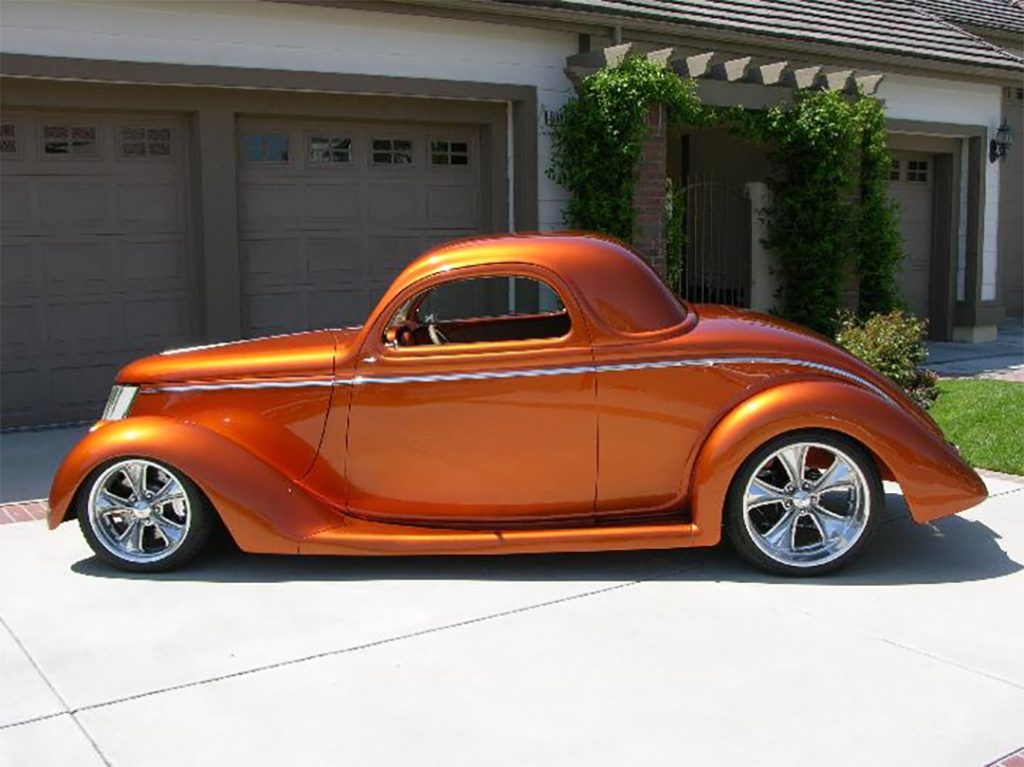The name Chip Foose resonates with car enthusiasts worldwide, and for a good reason. His exceptional design talent has given rise to numerous iconic creations, including the Plymouth Prowler, which derived its design inspiration from one of his school projects. While Chip’s fame shines bright, there’s a lesser-known but equally talented artist named Sam Foose, Chip’s father, whose artistic prowess laid the foundation for their successful collaboration.

The Legacy of Edsel Ford’s Vision: A Glimpse into the ’36 Ford Three Window Coupe
Ford’s designers, led by Edsel Ford, E.T. “Bob” Gregorie, John Tjaarda, and John Bonbright, pioneered the introduction of grace and streamlining to Ford cars during the mid-1930s. Their ingenuity led to the creation of the Lincoln Zephyr and brought a touch of elegance to Ford’s lineup. Interestingly, Henry Ford’s strict adherence to a fixed wheelbase of 112 inches stifled their creative wishes for a longer wheelbase.
Crafting the Masterpiece: Sam Foose’s Vision for the ’36 Ford Three Window Coupe
Sam Foose took up the challenge of transforming the ’36 Ford Three Window Coupe into an artistic masterpiece under his collaboration with Chip. The project involved intricate surgery, including a subtle chop to the top, elongation of the body, and a wedge section to achieve the car’s rakish line. The result was a stunning and streamlined appearance that breathed new life into the classic design.
From Obsolete to Outstanding: The Evolution of the ’36 Ford Three Window Coupe’s Aesthetics
The stock ’36 Ford’s hood and grille were incompatible with Sam Foose’s artistic vision, leading to the creation of a ’37-style three-piece hood. This change also introduced rear-mounted hood hinges, emphasizing the car’s streamlined appearance. Additionally, Sam expertly canted the grille and modified the fenders to create a unified panel, enhancing the overall aesthetic appeal of the coupe.
The Circle of Artistry: Sam and Chip Foose’s Collaboration and Its Significance
The collaboration between Sam and Chip Foose signifies a full circle in the family’s automotive history. Chip’s early exposure to his father’s craftsmanship sparked his passion for automotive design, which he further refined in prestigious studios and classrooms. This unique blend of experiences granted Chip invaluable insights into creating evocative designs, making his father proud of the legacy they have jointly created.
Conclusion
The 1936 Ford Three Window Coupe represents a remarkable combination of timeless elegance and modern craftsmanship, blending the genius of both Sam and Chip Foose. This car stands as a testament to the power of artistic collaboration and the impact it can leave on automotive history.
FAQs
1. Are there any other significant collaborations between Sam and Chip Foose?
While they have worked on several influential projects, the ’36 Ford Three Window Coupe stands out as one of their most prized collaborations, showcasing their combined talent and vision.
2. How did Chip Foose’s upbringing influence his design philosophy?
Growing up witnessing his father’s hands shape ordinary objects into personalized expressions ignited Chip’s passion for automotive design, paving the way for his exceptional career.
3. What makes the ’36 Ford Three Window Coupe an iconic collector’s item?
This car’s impeccable blend of classic elegance and modern design, along with the collaboration of two renowned artists, makes it a cherished masterpiece among classic car enthusiasts.
4. How did the Fooses achieve the coupe’s streamlined appearance?
By expertly manipulating the body, incorporating a ’37-style hood, and canted grille, the Fooses brought forth the car’s sleek and streamlined aesthetics.
5. Where can I find more information about the 1936 Ford Three Window Coupe?
For more details and an immersive experience, you can visit the official website or contact reputable classic car enthusiasts’ forums and museums.